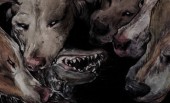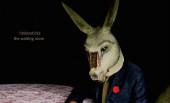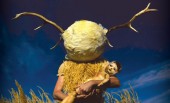Pop deaths are a fairly regular occurence – musician dies, briefly tops the trending charts on Twitter, everyone listens to their albums for a few days, fade to black, repeat. Most of the time the experience, I’m slightly ashamed to admit, leaves me pretty cold. Adam Yauch, Donna Summer, Etta James…great music, and sad to think they’re gone, but I didn’t know them and (this sounds harsh) I never expected to hear any great music from them again so didn’t see it as a huge personal loss.
That may be a selfish perspective, but it’s honest. People die every day, most of them after a far less pleasant lives than those enjoyed by, say, Robin Gibb or Davy Jones. Granted, anyone who’s acheived great things should be honoured and celebrated, but I don’t understand when people get genuinely distraught over people dying who they’ve never met, because they made a some decent records a few decades ago.
But the death of Broadcast’s Trish Keenan really did affect me. I was at work (on my own in a 2nd-hand DVD shop) and immediately went numb. Then that numbness thawed into a miserable bewilderment. I spent the rest of the day playing Broadcast albums, records which are among my favourite ever written, as the tears just about clung on to my lower eyelids. The tragedy of losing such a talented musician at such a young age seemed inexplicable (who the fuck gets pneumonia in Australia?), but it was a more selfish thought that really hit me: there would never be another Broadcast album to look forward to.
Because Broadcast were (are?) one of those bands whose every release was eagerly anticipated, chiefly because you ended up enjoying each one for different reasons. The pleated psychedelia of “The Noise Made By People”, the wintry splendour of “Haha Sound”, the infectious electronics of “Tender Buttons”, the hallucinatory cut-ups of 2009’s collaboration with The Focus Group (aka Julian House); each was a completely distinct and perfectly crafted work in its own right, but yet also contained all the classic Broadcast elements: vintage instruments, the odd twisted rhythmic excursion, and, of course, Trish Kennan’s voice, strikingly clear in tone and yet often feeling curiously reserved. You itched to find out what they would do next, mostly because you knew it’d be something new, and you knew you’d love it. When Keenan died, the thrill of that anticipation was gone forever, and however selfish it is: that hurt.
Or it did. Last year James Cargill, Keenan’s musical and romantic partner, announced that he was working on some recordings they’d made together to soundtrack a new film “Berberian Sound Studio”. The film is set in the 1970s and focuses on the psycholgical unravelling of a sound recordist from Dorking who takes a job in Italy working on a lurid horror flick. Perfect Broadcast territory, really – curious tropes of the past as seen through an experimental modern filter. That anticipation was back again.
Does the finished article satisfy it? Essentially, yes. It’s impossible to judge “Berberian Sound Studio” against other Broadcast albums though, mainly because it doesn’t feel like an album. There are 39 tracks in total, some just a few seconds long and many simply reinterpretating the primary motifs, not dissimilar to the obscure soundtracks and library recordings the band took so much inspiration from.
It kicks off with a descending auto-harp scale, similar to the one on ‘Lullaby’ from The Wicker Man soundtrack (which Broadcast already paraphrased on ‘I Found The F’, the opening track on “Tender Buttons”). The theme for proceedings – Broadcast meets cult 70s horror – is thus writ large early on, albeit in spidery handwriting.
The first track proper, ‘The Equestrian Vortex’, is more akin to something from “Broadcast & The Focus Group” – an off-kilter instrumental that sounds like it’s been sampled from some obscure prog record made by a practicing warlock who only exists in Julian Cope’s mind. The third track, ‘Beautiful Hair’, is a dreamlike death march, featuring Morricone-esque toy-box arpeggios and a backing rhythm that is somewhere between a disassociative-dosed convalescent quietly barking gibberish and a violin playing a single note, using a bow strung with the hair of an ancient corpse.
‘Teresa, Lark of Ascension’ is perhaps the highlight, and the closest we come to a ‘song’. It is utterly gorgeous, and one of the only tracks to clearly feature Keenan’s voice, which generally only appears in flashes, heavily painted over by other sounds. Here, her singing is refracted over a chiming ostinato and a surprisingly warm and lulling organ. Slowly everything dissipates, like mist clearing from a Hammer Horror cemetery, and the organ takes over the lead, before delicately handing it back again for a genuinely affecting, gentle coda.
A few bits of the album are similarly (and surprisingly) delicate, so in order to remind you that you’re supposed to be listening to a horror soundtrack Cargill chucks in a number of grisly sound effects. Sudden bursts of garbled human speech, stangulated seizures, shattering glass, bloody thuds and good ‘ol female screaming all pop up, while ‘A Goblin’ features someone speaking in tongues while a kettle approaches the boil somewhere in the seventh circle of hell. Elsewhere classic horror sounds are common, such as a slice of melodramatic church organ or haunting choral pieces sculpted out of Keenan’s recordings.
Getting the soundtrack to feel so authentic is an impressive achievement, and Cargill elaborated on his methods in a fascinating recent interview with FACT, revealing he used “mostly mellotron – its presets are pre-recorded tape loops so it inherently has that sound…I also used a dictaphone to record the autoharp and cymbals. I was conscious of the pastiche aspect to making a soundtrack like this, but I couldn’t see a way round it in the end…Gilderoy is working in an Italian sound studio in 1976 so I had to be considerate of that”. The line between pastiche and tribute, reverence and rip-off, is a pretty fine one, but suffice to say he refrains from straying beyond the better side of it.
So, how does it rank alongside Broadcast’s other records? Well, it doesn’t – it’s not an album. While it has an introduction, it has no narrative or ending and the brevity of many tracks makes it seem a little bitty when consumed as a whole. Like much “hauntological” music it feels more like a document than anything else, a memory of a place that never existed.
As a tool for coming to terms with the bizarre grief that I feel for a musician I never met, a feeling that usually confuses me when observed in others, it’s completely successful. There’s a reverence here, especially on the aforementioned ‘Teresa, Lark of Asenscion’, that makes it feel like the music that plays as you exit a crematorium, with that peculiar, amiguous mixture of total, unbearable heartbreak and the thought – “I wish to hell they were still here, but thank heavens they existed in the first place”.
Essentially, with Keenan’s voice often shadowy and always wordless, it feels a bit like Broadcast’s ghost. There are rumours that, with a seperate album having been in production while this soundtrack was being composed, there could be another Broadcast release later in the year. If true, then the anticipation the band’s always inspired lives on. If not, then ‘”Berberian Sound Studio” is as fitting a triubute as you could ask for.






Follow us
Follow us on Facebook Follow us on Twitter Follow us on Google+ Subscribe our newsletter Add us to your feeds